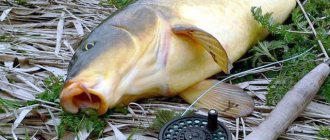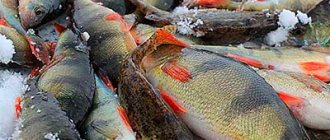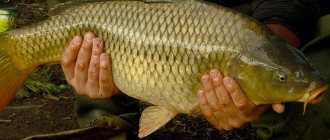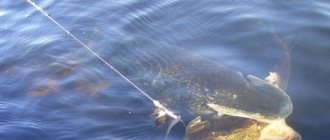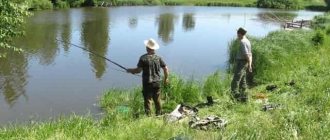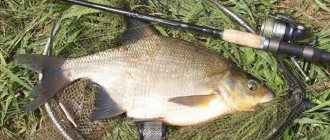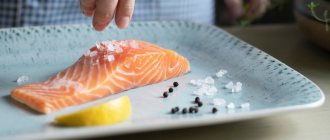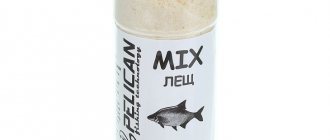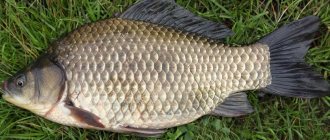Carp behavior in summer
The behavior of carp in summer differs little from that in spring, with the difference that during particularly hot sunshine it goes into muddy pits or waits out the heat under tree canopies. Therefore, the best time for fishing is on days when the maximum daytime temperature is 26-28 degrees - morning and evening. On particularly hot days, it makes sense to fish for carp at night. When is the best time to catch carp?
In June, carp are caught using top-shelf, feeder and bottom rigs during daylight hours, and at dawn or at dusk they go to shallow areas of ponds.
Carp in July . The entire month of July (with rare weather exceptions and the northern regions) is hidden from the heat in pits at depth. Ideal time for bottom gear. Fishing is mainly from early morning until lunch, and after, at dusk.
Carp in August . From mid-August to the end of September, carp and carp begin to eat again (as in principle, all cyprinids), so it becomes easier to catch them. Closer to autumn, they begin to increasingly use animal baits - worms, maggots.
During the summer, the carp becomes very saturated and, as a result, grows. It gains a lot of weight and size, which is why in the fall you often come across trophy individuals weighing 6-8 kg.
Where to look for carp in summer
As was said, at high temperatures (from 26-28 degrees), carp should be looked for in muddy pits or under canopies; they go deeper. In the sultry heat, it is better to catch carp before 12 noon and after 8 pm . In the cool summer , in the northern and eastern regions of Russia, carp are caught mainly during the day , often at depths of up to 2.5 meters ; during the day it comes out to bask in shallow areas of reservoirs. He also loves:
- Snags, fallen trees;
- Shallows;
- Seaweed;
- Reed thickets (more often found on the pond);
- Reeds, cattails.
Carp fishing in August
In the first days of the month, carp behave the same as in July. But towards the end of summer, the weather becomes cloudy and it rains more often. After rain, and when the sun is hidden behind the clouds, carp fishing in August is the most promising. A stable, albeit slight, decrease in temperature helps to activate the fish. From the second half of August, the carp begins to gain fat intensively. High activity is observed in the early morning, before sunset and at night. But throughout the night the carp bite is unstable. There are hours of complete no-bite, and moments when bite alarms on different gear start ringing simultaneously. Activity hours are difficult to determine in advance. Much depends on the size of the fish population in the reservoir. It is better not to focus on a specific time, but to plan fishing for the whole night.
Carp in August are more voracious compared to other summer months, so you should not skimp on bait. For long-term fishing (more than 2 days), bait should be used. It allows you to keep the fish in the baited area for the entire fishing period. Privada is a slowly washed-out complementary food. For example, you can fill a piece of nylon stocking with bait.
Catching carp with a float rod in summer
A less popular method for catching carp, but more effective for fishing on the surface, is a float rod.
- The fishing line for the float tackle is taken with a thickness of 0.22 mm to 0.30 mm , monofilament.
- Hooks according to international classification No. 4, 6, 8 .
- Pointed floats 10-14 grams .
- Sinkers of several pellets to load the float. One large shot is attached directly under the float. Loading occurs based on the weight of the float and should not be difficult.
You can make a bottom float with a sliding leash . To do this, you need to fix two sinkers at a distance of 15-20 cm from each other. This rig allows you to use Pop-Up corn with neutral buoyancy.
Fishing on the side nod
Used largely for boat fishing, but can also be used for shore fishing with carp fishing rods 5m or longer in length. Line 0.2 mm to 0.28 mm . Hooks on jigs from No. 4-8.
The side nod is used in conjunction with summer jigs. In this way, in the summer they catch not only carp and carp, but also crucian carp.
The advantages of such equipment:
- In a noticeable bite of small individuals and in the ability to pull out large ones.
- In the absence of numerous gear with a greater possibility of hooks and overlaps.
The rod for such gear is taken from 4 to 8 meters . Equipment options :
- Rods with rings and any reel (for working at different depths).
- Light reel on the 1st-3rd leg of the rod. This will allow you to fold the knees while fishing for carp.
A bright ball or marker is placed at the end of the nod to monitor the bite.
Variations of attaching a side nod.
- Angled wire with the letter “G”.
- Ready-made purchased options with the ability to mount on the tip of a fishing rod.
Playing with a summer jig . If you are fishing from the shore and the rod is long, you don’t need much play - the rod itself will swing from vibrations. With a short rod, the game is played in a slow, angular figure eight (picture on the right).
The frequency of movements is 2-3 seconds. Practice your jig play outside of the water.
Video on catching carp with a side nod in the summer:
Choosing a place to catch carp
The issue of determining a place for fishing is simplified in specially stocked reservoirs of fishing bases. Here you can always use the services of base workers.
Choosing a place to catch carp in natural conditions is more difficult. Depth measurements are carried out in advance. In summer, large carp move along the bottom depressions and feed at a depth of 3 meters or more. At night, you can expect fish to come out to the edges, located at a depth of about 2 meters.
Bottom gear
Fishing with bottom gear is carried out in early summer and at the end of August, when cool days begin again.
Fishing for carp with a classic feeder
To catch carp on a feeder you need:
- Fast-medium action rod, weight from 60 grams.
- Line from 0.26 mm to 0.32 mm .
- Know the structure of the bottom. Recognized by an echo sounder, a marker rod, or by probing the sinker.
- Proper supply of bait to the fishing spot.
- Correct selection of main line and leash:
- Rigid equipment . Braided cord for leash.
- Combined leash . Basic monofilament, braided hair.
- Soft . Fluorocarbon leader, monofilament main line.
Feeder equipment used for carp:
Method. Open feeders with a load of 30 grams. Uniform distribution of bait along the bottom. Easy casts, low chance of hooking.
Paternoster . For carp, options with sliding equipment are used to adjust the position of the boilie relative to the bottom, and with an anti-twist tube to protect connections and reduce the likelihood of overlaps and snags. Most often used in weak currents.
Leaders are made of fluorocarbon with a thickness of 0.2-0.24mm. The main line is braided 0.22-0.28 , sometimes 0.32 mm . Hooks are taken according to the classics, from 4 to 8 and 9 sizes. The combination is a hair rig with corn, or less commonly, boilies.
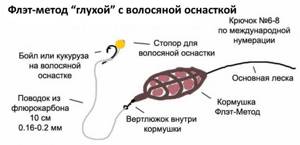
Step-by-step knitting of equipment with a detailed indication of the elements is indicated in the links above.
Fishing for carp on a feeder . Casts are made from behind the back, the first 5-7 casts are made with bait (2-3 if fishing on a paid pond). Bait can also be delivered by rocket. Re-cast the gear every 15-30 minutes. To signal a bite , bells and electronic bite alarms are used.
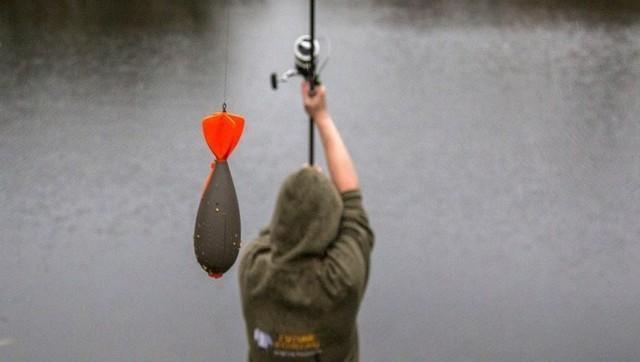
Makushatnik
Tackle based on sunflower seed using 1-4 hooks and the same number of leashes, respectively. Makukha is pressed seeds and residual products from the processing of sunflower raw materials - a kind of briquette.
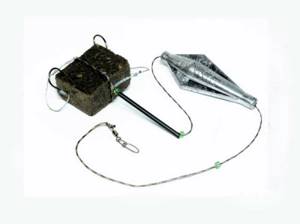
Homemade makushatnik. Option with a tube (cambric)
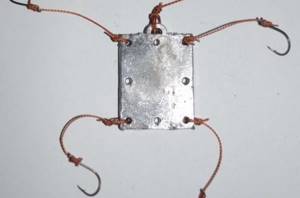
The number of leashes and hooks is not limited, but the use of such equipment may be prohibited in some conditions. An option for attaching the crown to a metal plate.
Makushatnik is easy to make with your own hands. The tackle is attached to the main line through swivels or quick releases. The crown itself is fixed on a metal plate measuring 3x4 centimeters. There are holes in the plate for the integration of leads. The crown is fixed with ropes (thick threads). The load starts from 30 grams, depending on the strength of the current.
The advantage of such gear:
- Possibility of fishing with a regular inertial reel..
- Easy to manufacture.
- Versatility - can be used under any conditions.
- Efficiency due to the number of hooks.
Video on catching carp on a makushatnik:
Fishing with mugs (summer girders)
Some may call it a tackle for the lazy, others may say that this is not really fishing, but the truth is that the fishing process is unusual and extremely effective.
What is it?
A circle vaguely reminiscent of a spinning top. In the center is a beacon or antenna with a bright ball; the length of the antenna should be 1.5-2 times the diameter of the circle. When bitten, the ball goes down, making it clear that the fish has been caught.
The tackle is attached to the bottom (back) side of the circle. Heavily loaded hair rig with silicone anti-twist tube. Weight from 90 grams.
The dimensions of the circle for carp are 10-15 cm . The thickness of the mug is 20-30 mm . The main line is from 0.3 mm to 0.45 mm thick , the leader is from 0.18 to 0.26 mm.
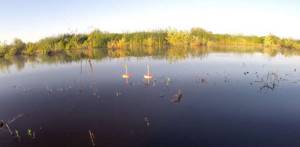
Material:
- Styrofoam . Any type will do – polyurethane, polyvinyl chloride, polystyrene, urea-formaldehyde, etc.
- Plastic . Higher density, less sensitive tackle.
- Foampropylene . The best option.
Pros:
- No need for a rod.
- There are no overlaps.
- There is a minimum of sounds and movements, which is good when fishing for carp.
- Places that are difficult to fish with a fishing rod become accessible.
- Minimal participation of the fisherman.
Minuses:
- Not sports gear.
- Often prohibited on paid ponds.
- Application is reasonable only from a boat.
- If you make the tackle incorrectly, the carp can drag it all under water, turning the circle over.
How to make circles on carp, video:
Catching carp with mugs, video:
Hair rig
We have already discussed it in detail in other articles, but we will repeat it.
Without exaggeration, it is considered the main equipment for carp fishing. A distinctive feature of this type of gear is that the bait is attached not to the hook, but to the “hair”, which is located in close proximity to the hook. This allows you to more accurately hook the carp and not tear the delicate tissues of its oral cavity. Realizing that there is food in front of him, he sucks it inside, absorbing the hook after it. The following are used as bait:
- Corn;
- Boyles;
- Peas;
- Worms;
- Mixed baits (corn / worm, etc.).
The length of the leash for hair rigs varies between 20-70 centimeters, depending on the fishing conditions. A 50 centimeter leash is used when fishing with a classic feeder, such as a paternoster, inline or asymmetrical loop. The thickness of the braided cord is 0.18-0.28, depending on the weight of the intended carp. Hooks for small carp No. 8, for medium carp No. 6, for large carp No. 4 and No. 2 for trophy carp (according to the international classification).
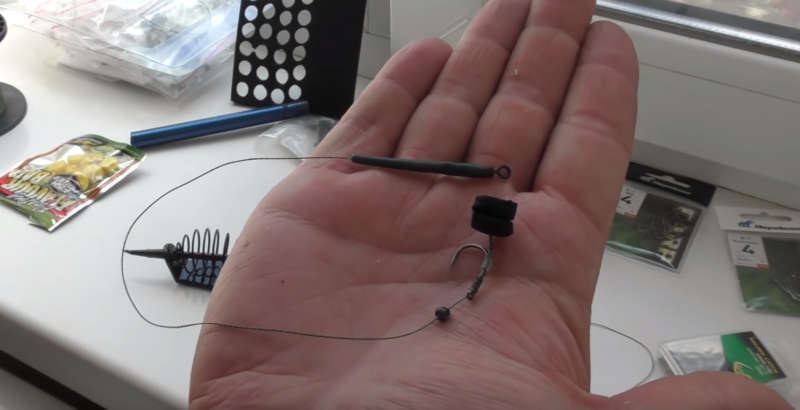
Gear device.
The hair ends in a loop into which a small stopper to secure the boilie or corn. Then there is a hook, on which there are 8-10 turns of fishing line, a silicone / rubber / plastic tube is threaded onto the hook to stabilize the hair. Next comes the loading (necessary if fishing with floating, pop-up boilies) then connecting with a quick release or a regular swivel.
More detailed video on knitting hair:
How to catch carp in summer?
As for the habitat, carp feels excellent in almost any body of water. It can be caught in small and large rivers, reservoirs and small isolated ponds. If carp grows in the wild, it is usually called carp. The body of this carp is somewhat elongated. Domesticated species prefer to be in bodies of water with weak or no current. Such reservoirs usually have a muddy or clayey bottom. Carp especially like the deep and wide areas of lakes and ponds. He likes warm water. Carp prefers to stay in depth.
Many fishermen note that the bite becomes unpredictable in the summer heat. This is due to the fact that some fish species have already spawned, while others have just started spawning. Carp is caught especially well in summer, because it begins to eat not only at night, but also during the day. True, it is much more difficult to catch it in the daytime, but this is only true from the point of view of camouflage in small places. Fishing in shallow water throughout the hot season gives good results for one simple reason: fishing is carried out in the natural feeding areas of this fish.
Feeding place. It makes sense to divide reservoirs according to the nature of their shallow zones and bottom topography. First, let's talk about deeper reservoirs such as quarries with a shallow coastal zone. If you are fishing in such a reservoir, then look for carp at the very border with coastal vegetation or in thickets of plants. It is interesting that carp will not climb into the thick of this very vegetation. He stays in the passages of the bays to have a better view and room to escape in case of danger.
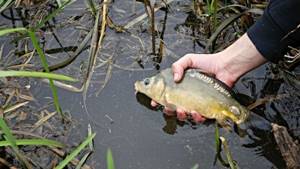
In such places, carp do not last long. It is possible to catch a fish here, but this probability is based more on luck than on calculation. In this case, only a good knowledge of the habits of the carp living in a particular body of water will help. This refers to the behavior of the fish, depending on the temperature of the water and air, as well as the direction and strength of the wind.
The next type of reservoir is characterized by a wide shallow coastal zone. Here the carp has constant routes of movement, favorite feeding and parking areas. The width of this zone can reach several hundred meters. Here it makes sense to prepare a place and carry out baiting or feeding of fish. This must be done at the predicted hours in anticipation of bites.
Time to catch. Carp go to their favorite feeding spots at certain times of the day. In some reservoirs this happens in the afternoon, while in others fish can be caught at night. Sometimes it makes sense to fish before dawn. Carp bred in captivity are trained to specific feeding times. At such hours, the fish wait for food and are not caught with amateur gear. If you do not feed the carp, as they say, in a planned manner, then the hour of its feeding can be determined solely by the availability of the food supply of a given reservoir at a time known to the carp. That’s why, before going to a pond, it doesn’t hurt to figure out when the first fish bites usually begin.
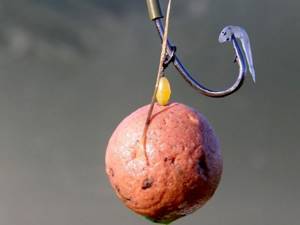
Lures and Lures
Canned corn and peas are classic baits for summer carp
. Basic carp baits:
- Boilies.
- Worm.
- Maggot.
- Bloodworm.
- Corn.
- Peas.
- Pearl barley.
- Potato.
- Bread.
What do carp bite on in summer?
In summer, carp bite mainly on corn and boilies . Both baits are dipped in anise oil to add more flavor, and, accordingly, an increase in carp bites.
What boilies should I use?
With the taste of bloodworms, honey, citrus essential oils. Good store-bought ones are Richworth Euroboilies 20 mm, Dynamite Baits with crab flavor.
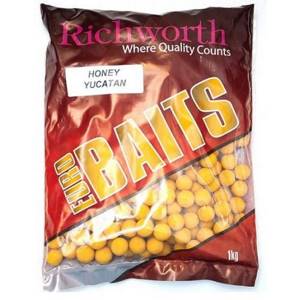
Animal baits are not used in the summer, but can be used in the absence of a bite:
- A bunch of worms, combined with corn.
- Maggots are added to boilies, both during the manufacture of boilies and additionally on the hook.
- Sandwiches made from maggots and worms.
Vegetable baits
In summer, it is advisable to catch carp using vegetable baits or artificial baits with flavors - boilies. In warm weather, anglers most often choose young corn as bait, fresh, boiled or canned. But carp can also be attracted by several grains of wheat, young peas, pearl barley and oatmeal on a hook. Hard grains need to be boiled or steamed - this way they acquire the softness necessary for planting.
Corn
The most popular bait for carp is corn. It is suitable for catching both large and small specimens. The choice of equipment when using corn is predetermining; you can use hair, method, float, Bolognese and others. How to properly plant young corn on carp is a controversial issue; there are several methods.
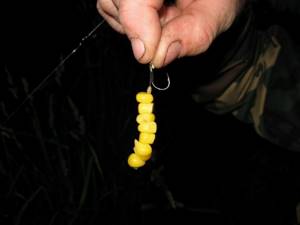
When using hair rigs to catch large carp, it is advisable to use several corns as bait. In this case, even if a small fish eats 1-2 seeds, the large carp will get the bulk of the bait.
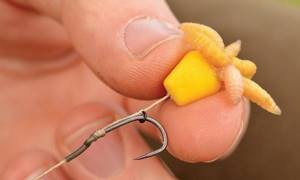
When fishing for carp in April, May and June, it makes sense to use not only corn as bait, but also several live fly larvae - maggots. Firstly, this bright bait will attract even picky fish, and secondly, it can tempt both herbivorous and “predatory” carp to bite, which is especially important when fishing during the transition period. The disadvantage of such equipment and bait is that small fish - roach, crucian carp, rotan - can quickly peck at it.
When fishing with float gear, corn can be hooked directly onto the hook, without the use of hair equipment. You can also use boiled and young peas, pearl barley, wheat and other vegetable baits along with corn seeds.
Peas
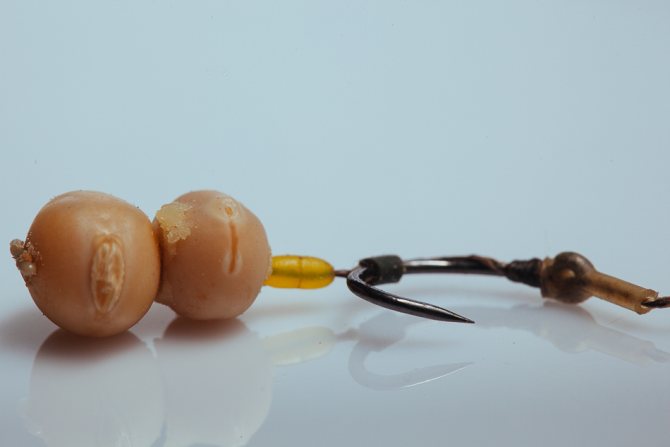
On some reservoirs, fishermen noticed that large carp bite better on peas. As in the case of corn and boilies, it is better to place it on a hair rig in the amount of 2-4 pieces. In fishing stores you can find both corn and peas with various flavors. But in order to save money, you can prepare pea seeds yourself or buy canned peas; fresh, young peas are also suitable for carp. Its use as bait is similar to that of corn.
Pearl barley
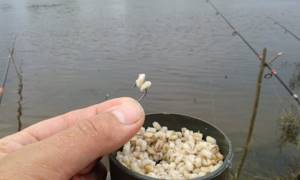
All carp fish species like pearl barley
Pearl barley porridge is usually used when fishing for crucian carp, but if you add flavorings to it during cooking, you can also attract carp with this bait. According to the observations of fishermen, carp readily take pearl barley if it is used together with maggot, corn, peas or boilies.
Potato
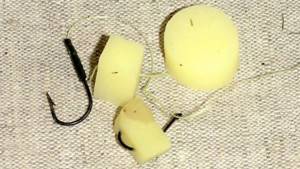
The potato cube is an effective bait for catching carp in all fishing games - this is true
Potato cubes or lump potatoes for carp are used by many professional fishermen. This root vegetable is suitable in any form: raw, fried, boiled, with or without flavorings. At the same time, as is the case with other baits, when catching carp with potatoes, it is also advisable to use a hair rig - this way you can cut off small fish, such as crucian carp and roach, which are also often tempted by potatoes. Natural baits are a great way to go carp fishing without buying expensive boilies - but not always effective when trying to catch trophy carp.
Semolina and dough
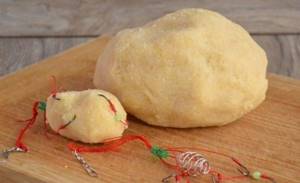
In conditions where there are no small fish in the reservoir, or they feed only near the surface, it makes sense to catch carp using semolina and dough, the main thing is to prepare them correctly. If there is a lot of small stuff in the pond, then the semolina will not have time to attract cyprinids and will quickly be eaten before it reaches the bottom. Semolina and dough are very effective when catching crucian carp, especially with a “crucian carp killer” tackle with a spring feeder.
Do-it-yourself bait
There are many variations, but every summer bait for carp should contain sunflower cake, which carp loves so much. It is better to feed 2-3 days before fishing, purposefully in the same place.
Summer recipe for carp No. 1 discontinued
For 1 kg of final mixture:
- Cake 200 grams;
- Corn flour 200 grams;
- Canned corn 100 grams;
- Pellets 200 grams;
- Semolina 200 grams;
- Powdered milk 100 grams.
Corn is needed for a large fraction. All ingredients are mixed until a homogeneous dry mixture. Moistened with water from a pond to give the desired stickiness.
